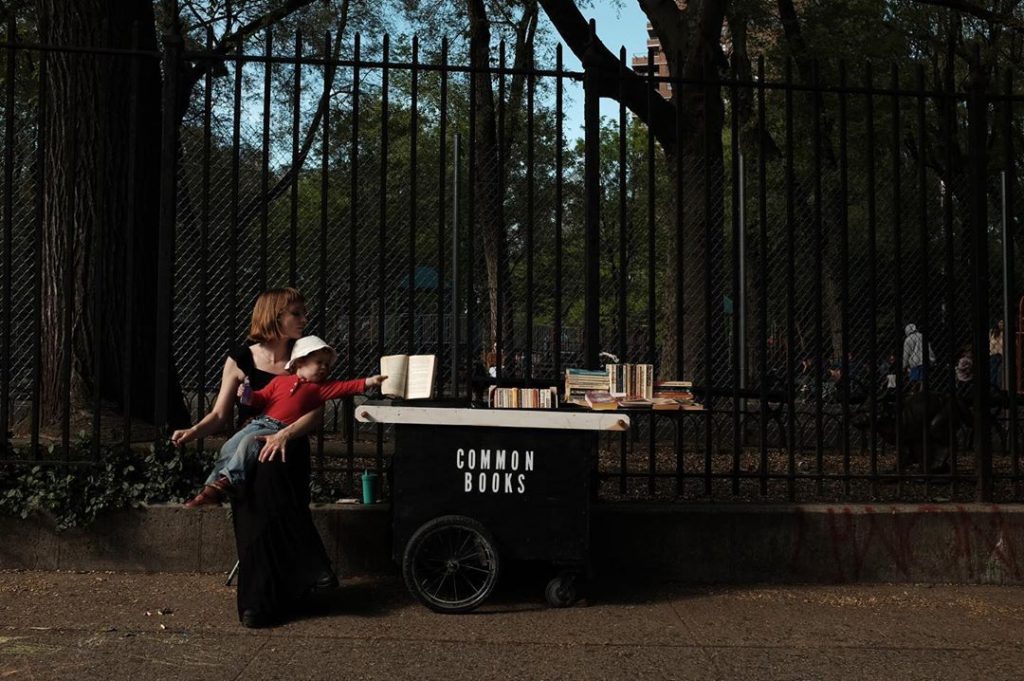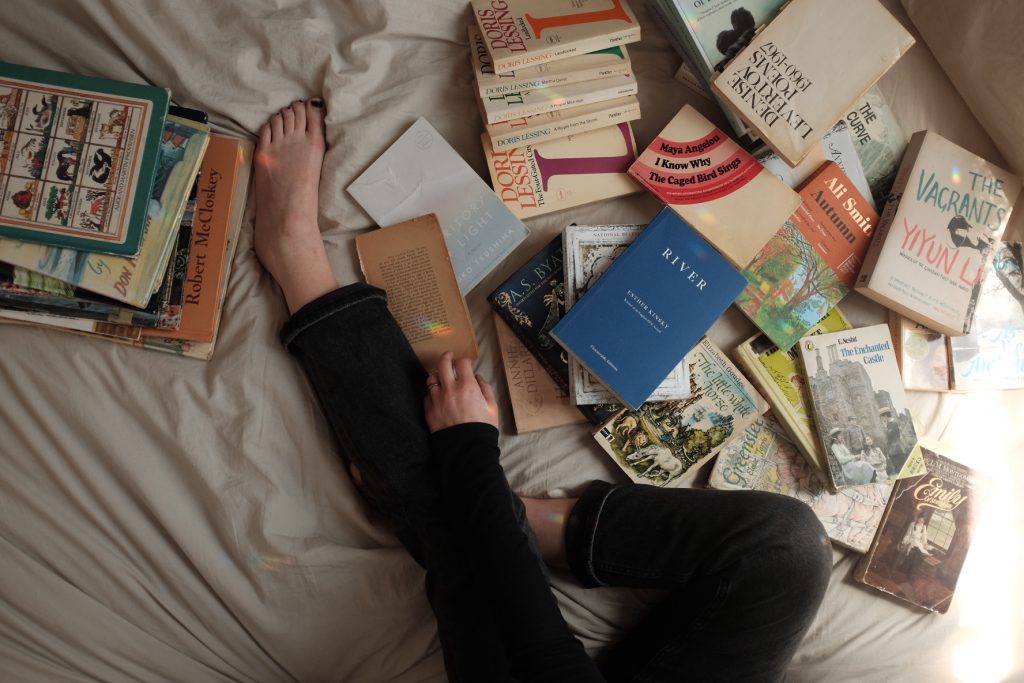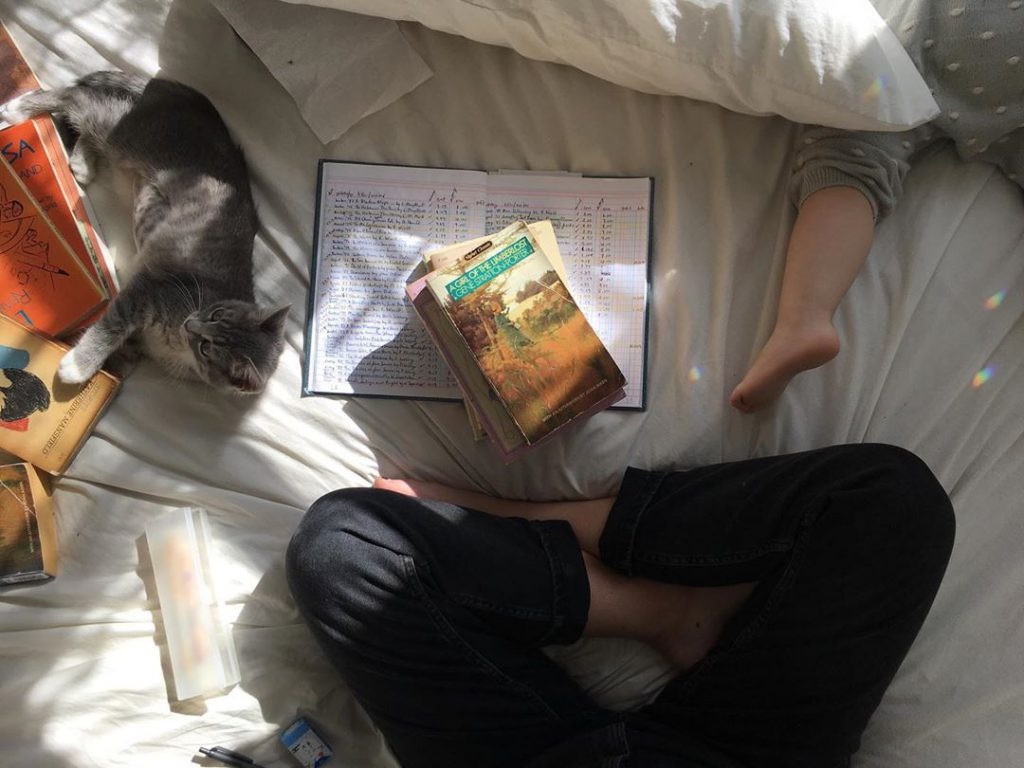
Brittany is a bookseller and mother who lives in Chinatown, NYC. She wrote this piece for us about reading habits during quarantine—turns out it’s not quite as straightforward as reading during healthier times, but still offers a chance for escape and new perspectives. And isn’t that what we’re all looking for?
Back in February and early March, when we could see this viral tidal wave approaching but before we had any guidelines, I had thoughts of again enjoying those long childhood days when you hole up somewhere with a stack of books taller than yourself and regain consciousness hours later surrounded by ragged piles (finished, loved, bored, tossed aside, read again).
Then the wave crested—and crested again and again—and with its global and citywide weight and sorrow, my own, smaller, reader’s reality emerged: I have a three year old who hasn’t started school yet, so my available reading hours have stayed about the same. The same, minus the park bench reading while she ran free. And the subway reading. And the weekend afternoons reading beside my bookcart. And the laundromat reading (that was always hit or miss, if I’m honest… the door to the street was always wide open and those laundry carts are too tempting for a toddler to resist). OK, so there’s less reading time.
I will say, I think we all—me, toddler, spouse and cat—have gotten better at doing our own thing side by side or often literally on top of each other (I’m particularly looking at the toddler and cat here, but no one is blameless on this front). I still have some nap-times to sprawl out on my bed or, on sunny days, perch on my fire escape to read (although I’m distracted by my internal shouting at people to wear masks and stop hogging the already-too-narrow sidewalk).
The first few weeks, I could not focus on books, tv, or anything else, but I gradually figured out that now is not the time for winding, melancholic novels, or books that relish the physicality, the shoulder-to-shoulderness of the city. I kept finding myself angrily writing “March 2020, NYC!!!” in margins where I deemed the characters to not be taking my own current events sufficiently seriously.

via Instagram
Books that helped me read again:
So I switched to books about conditions I considered worse than my own (really not hard to find once I realized that’s what I needed). I read Maya Angelou’s I Know Why The Caged Bird Sings—sufficiently worse than my condition, and also has that childhood appeal. I read The Vagrants by Yiyun Li—about the cultural revolution in China—and learned why my neighborhood exists (I live in NYC’s Chinatown). My fire escape readings grew richer and more full of wonder during this read; while gazing on the elderly walkers and stoop sitters beneath me I mused: “Did you escape this? Did you live this moment? Or none of it? Are you, like me, here for the love of this city?” I spent a great deal of time googling the events referenced, my brain fairly sparking with new synapses. In this time of misinformation from the top tiers of our government inciting racist attacks on people of Chinese or other Asian backgrounds, I highly recommend immersing yourself in the works of Yiyun Li and other writers of Asian backgrounds. You will not regret it.
And then I found I could read again, filling the cracks between books with volumes of poetry, dipping back into Margaret Atwood, and Anita Brookner (her microscope on small lives has been startlingly relevant: “They managed to be so busy doing the little they had to do…even when they took a rest in the afternoon they made it sound like an assignment to be filled in a busy day.” A Start In Life by Anita Brookner). I start to find myself scribbling, “April 2020, NYC” with the flash of being known instead of the flash of anger.
Then, of course, any gap not filled by poetry is filled by picture book after picture book. We have been gravitating to city books, as always, but now fueled by nostalgia as well as familiarity: The Boy Who Didn’t Believe In Spring by Lucille Clifton (who also happens to be one of the poets glueing this time together), The City Book by Lucille Corcos, Corderoy, Fly High Fly Low and Inspector Peckit (different cities but no less loved by us and pigeons) by Don Freeman, Tar Beach by Faith Ringold. And on the other end of the spectrum we’ve been soaking in the opposite, pastoral and sea-soaked books: One Morning in Maine and Time of Wonder by Robert McClosky (over and over and over), The Year At Maple Farm by Alice and Martin Provenson, and Play With Me by Marie Hall Ets (this one feels especially relevant and a bit sad during isolation— a little girl trying to play all alone in a meadow… the meadow makes my daughter a bit jealous but she can’t look away). And of course, the comfort of old friends like Judith Kerr’s Mog.

Books I thought I would read:
I find myself craving books from the past, but when I try them I curse my memory: turns out it’s hard to focus on a book when I can fill in the rest of the pages in my head as I’m reading. Too much down time for the brain to wander. I tried fondly battered paperbacks that I’ve hauled 3,000 miles across the country over the past decade—The Little White Horse by Elizabeth Goudge, Emily of New Moon by L.M. Montgomery, The Four Story Mistake by Elizabeth Enright, Greensleeves by Eloise Jarvis McGraw. I started reading The Lion, The Witch and The Wardrobe aloud to my three year-old (maybe a stretch but we’re making slow progress). I kept mentally wandering aboard Mrs. Barrable’s boat, The Teasel, then remembered I hadn’t yet tracked down the 70s Puffin paperback edition of Coot Club (we all collect the perfect edition of books for our kids to read in the future, right? They definitely will appreciate these painstakingly curated shelves, right?).
Then there are the books I’ve wanted to read for sometime now, but only exist in large, heavy hardback editions—I am a city mother, and there’s no way I’m carrying The Very Rich Hours of Adrienne Monnier and a three year old and a stroller up and down the subway stairs. Or the complete works of several poets I’ve been meaning to finish. Although I haven’t been on the subway in over two months now, heavy hardbacks still feel weird to me. I love my books fat, battered and pocket-sized. I did finish reading the complete works of Jane Kenyon—her poetry was neither about things sufficiently worse nor particularly relevant but I found her microscope on the ordinary to be oddly applicable to this time when so many of us are so very busy doing so very little.
I keep thinking of books I wish I hadn’t read recently so I could read them for the first time right now. I recently discovered that The Children’s Book by A. S. Byatt was written about the real children’s book writer, E. Nesbit. Once I forget more of The Children’s Book I want to re-read it alongside Nesbit’s The Enchanted Castle and The Treasure Seekers—maybe when my daughter is ready for those as read-alouds—but it would have been nice now. Other books: Elena Ferrante’s Neapolitan Novels, The Ministry of Utmost Happiness by Arundhati Roy, The Children of Violence series by Doris Lessing…you know, long, lose-yourself-able kinds of books.
Oh! and The Curve of Time by M. Wylie Blanchett and Once Upon an Island by David Conover—which brings me to my next category:
Books that remind me of my home in Washington State’s inland seas:
I gave re-reading another try, and while those felt very friendly and I paused to read a chapter here, a sentence there, half forgotten words rushing to meet me again like “tidebook” and “phosphorescence”, I still couldn’t focus on the whole. So I’ve been reading anything by Annie Dillard from her Puget Sound years, which I had somehow not read until now.

Long before I became a bookseller, I was already biased toward the theory of the antilibrary and bookselling has only given this habit a better excuse. If you don’t know, antilibrararians are those who have the habit of accruing books whether they need a new read or not. I sell used books on the streets of NYC’s Lower East Side in healthier times, and every day I’m out I am asked at least once if I’ve read every book in my bookcart. While I do usually tuck away a battered copy of most books I sell (like a bookish survivalist), it will be a sad day when I have read every single book I own. As Nassim Nicholas Taleb says (about writer Umberto Eco’s library and reading habits), “Read books are far less valuable than unread ones. The library should contain as much of what you do not know as your financial means…allows you to put there.” (Incidentally, that last clause, the financial means one, is why I sell used books—books to the people!)
We didn’t consider fleeing our city at this time for practical reasons, but also because I know myself and there’s no way I could haul enough books—or exactly the right ones for my very mood-based reading habits—to wherever we would escape to. I can never commit to a “to be read” pile… each book read inspires a new craving.
The patterns of blue light across the ceiling in Yūko Tsushima’s Territory of Light, somehow led me to cats among geraniums and the clatter of cutlery on a boat in the outskirts of London in Esther Kinsky’s River, which led to Denise Levertov’s unease of trees in Say the Word, and “The authentic, I said/ rising from the toilet seat./ The radiator in rhythmic knockings” of motherhood’s early morning in Levertov’s poem Matins, then to unravelling truth and lies beside a bed in a nursing home in Ali Smith’s Autumn (read in this still unsprung spring), and on to the brutality of age in another nursing home bed in May Sarton’s As We Are Now.
Now is the time to have access to unruly piles of books to riffle through—hurry! before the glow of the last book has faded.

Friendly reminder from Brittany and us at SWC: always buy from independent booksellers, especially now! Call your bookshop and see if you can request some of these titles for contactless pickup or shipping. And if you can, buy living writers’ books new!
Follow Brittany on Instagram at @brittanymbond and if you’re in NYC, visit her bookcart in the LES on weekends (and other times announced on Instagram). During non-pandemic times, she ships her books; all perfect paperback editions and just the right size for stuffing in pockets.
